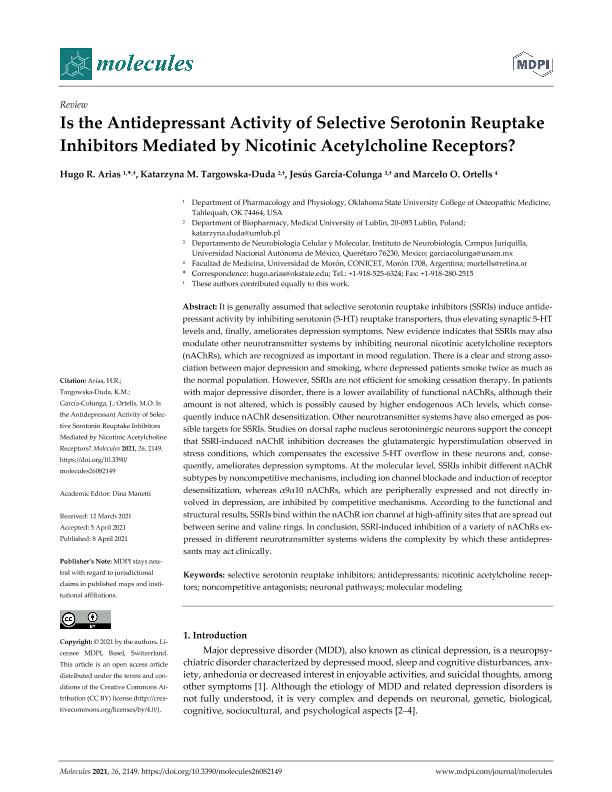Mostrar el registro sencillo del ítem
dc.contributor.author
Arias, Hugo R.
dc.contributor.author
Targowska Duda, Katarzyna M.
dc.contributor.author
García Colunga, Jesús
dc.contributor.author
Ortells, Marcelo Oscar

dc.date.available
2022-08-12T10:26:18Z
dc.date.issued
2021-04
dc.identifier.citation
Arias, Hugo R.; Targowska Duda, Katarzyna M.; García Colunga, Jesús; Ortells, Marcelo Oscar; Is the antidepressant activity of selective serotonin reuptake inhibitors mediated by nicotinic acetylcholine receptors?; Molecular Diversity Preservation International; Molecules; 26; 8; 4-2021; 1-21
dc.identifier.issn
1420-3049
dc.identifier.uri
http://hdl.handle.net/11336/165313
dc.description.abstract
It is generally assumed that selective serotonin reuptake inhibitors (SSRIs) induce antidepressant activity by inhibiting serotonin (5-HT) reuptake transporters, thus elevating synaptic 5-HT levels and, finally, ameliorates depression symptoms. New evidence indicates that SSRIs may also modulate other neurotransmitter systems by inhibiting neuronal nicotinic acetylcholine receptors (nAChRs), which are recognized as important in mood regulation. There is a clear and strong association between major depression and smoking, where depressed patients smoke twice as much as the normal population. However, SSRIs are not efficient for smoking cessation therapy. In patients with major depressive disorder, there is a lower availability of functional nAChRs, although their amount is not altered, which is possibly caused by higher endogenous ACh levels, which consequently induce nAChR desensitization. Other neurotransmitter systems have also emerged as possible targets for SSRIs. Studies on dorsal raphe nucleus serotoninergic neurons support the concept that SSRI-induced nAChR inhibition decreases the glutamatergic hyperstimulation observed in stress conditions, which compensates the excessive 5-HT overflow in these neurons and, consequently, ameliorates depression symptoms. At the molecular level, SSRIs inhibit different nAChR subtypes by noncompetitive mechanisms, including ion channel blockade and induction of receptor desensitization, whereas α9α10 nAChRs, which are peripherally expressed and not directly involved in depression, are inhibited by competitive mechanisms. According to the functional and structural results, SSRIs bind within the nAChR ion channel at high-affinity sites that are spread out between serine and valine rings. In conclusion, SSRI-induced inhibition of a variety of nAChRs expressed in different neurotransmitter systems widens the complexity by which these antidepressants may act clinically.
dc.format
application/pdf
dc.language.iso
eng
dc.publisher
Molecular Diversity Preservation International

dc.rights
info:eu-repo/semantics/openAccess
dc.rights.uri
https://creativecommons.org/licenses/by/2.5/ar/
dc.subject
ANTIDEPRESSANTS
dc.subject
MOLECULAR MODELING
dc.subject
NEURONAL PATHWAYS
dc.subject
NICOTINIC ACETYLCHOLINE RECEPTORS
dc.subject
NONCOMPETITIVE ANTAGONISTS
dc.subject
SELECTIVE SEROTONIN REUPTAKE INHIBITORS
dc.subject.classification
Farmacología y Farmacia

dc.subject.classification
Medicina Básica

dc.subject.classification
CIENCIAS MÉDICAS Y DE LA SALUD

dc.title
Is the antidepressant activity of selective serotonin reuptake inhibitors mediated by nicotinic acetylcholine receptors?
dc.type
info:eu-repo/semantics/article
dc.type
info:ar-repo/semantics/artículo
dc.type
info:eu-repo/semantics/publishedVersion
dc.date.updated
2022-08-11T13:03:58Z
dc.journal.volume
26
dc.journal.number
8
dc.journal.pagination
1-21
dc.journal.pais
Suiza

dc.description.fil
Fil: Arias, Hugo R.. Oklahoma State University; Estados Unidos
dc.description.fil
Fil: Targowska Duda, Katarzyna M.. Medical University Of Lublin; Polonia
dc.description.fil
Fil: García Colunga, Jesús. Universidad Nacional Autónoma de México; México
dc.description.fil
Fil: Ortells, Marcelo Oscar. Consejo Nacional de Investigaciones Científicas y Técnicas; Argentina. Universidad de Morón; Argentina
dc.journal.title
Molecules

dc.relation.alternativeid
info:eu-repo/semantics/altIdentifier/url/https://www.mdpi.com/1420-3049/26/8/2149
dc.relation.alternativeid
info:eu-repo/semantics/altIdentifier/doi/http://dx.doi.org/10.3390/molecules26082149
Archivos asociados
